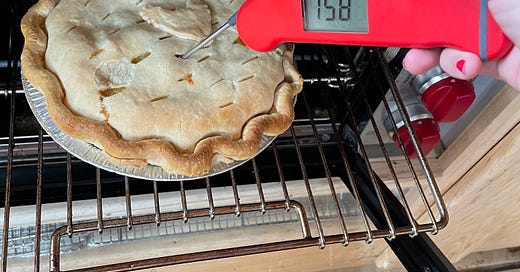This week, I cooked the perfect hard-boiled egg. The kind where the shell comes off in an egg hat and egg pants and nothing else. The surface of the egg looks like marble, feels like an oiled up baby, and when you slice it open, the yolk practically sings to you in the key of marigold yellow. Fucking perfect.
I’m aware this isn’t a huge accomplishment, but are we sure? This is boiling eggs at 10,000 feet after all, where the air is thin and the chickens are cold. And I, generally, am inept at cooking.
In Season 15 of Top Chef, the chefs competed in “Colorful” Colorado. I have watched every season of Top Chef. Like many people who love to eat but do not understand the basic chemistry of cooking and baking, watching Top Chef is essentially like watching the NFL. Just me eating popcorn saying things like, “look at those buns.” That season stood out to me because it seemed, more than any other season, to have a built in disadvantage because every challenge was at elevation. The chefs would yell about here and there, but the ranting and raving really came at their peak challenge: cooking at the highest elevation restaurant in America, Alpino Vino. Alpino Vino sits at just shy of 12,000 feet, and it’s a half hour and one chairlift from my house.
When I first ate at Alpino Vino, it was one of those rare moments when you’re like, “you know what? This is a 20 dollar sandwich.” It took at least 30 minutes to get that sandwich, but that’s tourist dining.
Or is that elevation cooking?
We’ve talked a little before about the effects of elevation on the body, so let’s get into the effects outside the body. When you go up, air pressure goes down. This we’ve learned, and while we as humans may not really feel elevation until about 5000 to 6000 feet, altitude begins to affect baking somewhere around 3,500 feet. For baked goods, this means they rise more easily. Makes sense — there’s, ya know, less pressure on them. And because there’s less pressure on keeping liquid molecules in liquid form, you don’t need as much heat to vaporize them.
Water boils at 212°F/100°C… at sea level. Or really, at standard sea level pressure. That boiling point drops about 0.9°F for every 500 feet you go up. So at my house, water boils at 194°F. Over at Alpino Vino, it goes down to 190°F. But (and I feel like this is obvious, but, I’m gonna say it) the water is cooler when it boils. This matters!
Think about pour over coffee. Coffee masters recommend you pour over at 205°F, but you can go as low as 195°F. My water can’t even get to that temperature! It’s busy evaporating! Water is actively evaporating at lower temperatures here and that goes for everything baked, broiled, and burned. We all know moisture makes a lot of food great. Dry chicken? Bad. Dry cake? Bad. Dry pork chops? Actually how I like them but not the point.
The fix for this is often to bake certain things at lower temperatures. The other fix? Experimenting.
I am not the experimenter. That’s Ben. But I do have a pot pie in the oven as I type. Three thousand feet lower than here is a food market in a bustling town of 800 people, and this market is known for one thing: pies. Cherry pies, chocolate pies, sirloin pies, chicken pies, all the pies. I went mountain biking in the area today and, it being off-season, I knew they would still have one of the favored pot pies. She’s sitting in the oven at 325 for 75 minutes. That’s what they recommended — we’ll see.
Less air pressure doesn’t just mean lower boiling temperatures, it also means that gases expand faster. If you want something to rise in the oven, it’s not unlikely it’ll rise and collapse before the inside is even baked.
To help with this, you can cut back on leavening agents (baking powder, baking soda, yeast, etc.) Basically, if you’re moving here to bake bread, bake some patience first. Since that leavening is faster, your gas bubbles come together into larger, more irregular pockets in the dough, giving you a coarse texture. It’s that or the pressure inside the batter becomes so great that the cells burst, and so does your bubble.
Because of the fast evaporation, it means some baked goods also stick more, cakes will refuse to set, and sugars go into overdrive. Good thing the only baking we typically do is cookies! And popovers. And biscuits. And croissants. And… alright, nevermind.
Back to eggs.
We are not homesteaders. Not one person in this radical hippie valley of extreme athletes has chickens. We’re all on 5,000 square foot lots. It’s April and it’s 38° outside with 60 mph wind gusts. One person has horses, but they’re only here in the summer. Everyone just has dogs and tiny greenhouses. There’s also a town greenhouse, but with literally no rules posted on how it works, we’ve been reluctant to take any greens. Instead, Ben is working out plans to build his own greenshack so he can meet all of my kale and arugula dreams. But until then, we’re buying all our food.
I may have to drive over an hour to get my dream pie, but for regular groceries, it’s 25 minutes to the town market. And it is expensive. It’s like shopping in Erewhon: the oat milk is always sold out and everything is a billion dollars.
Some context: I grew up eating Stouffer’s macaroni and cheese from the microwave. My parents made plenty of home cooked meals (love you guys) but it included a lot of canned and frozen goods. They’re just not foodies! Ben meanwhile grew up with a mom who turned down a job in Alice Waters’s kitchen. We have different relationships with food! When we met, I was very happy eating the pre-packaged hard boiled eggs from the office kitchen for lunch, and eating chips and salsa for dinner. Ben has essentially been spearheading a seven year intervention in my diet, which is pretty easy considering he cooks everything and I show up at the table in ongoing awe. Any time people are like, “does Ben have a job yet?” I’m like, “if you were ever on a Zoom with me, you would see his current job is delivering plates directly in front of the camera with things like homemade cinnamon rolls and custom ordered salads.”
So Ben is in charge of food. Moving from the produce mecca of California to a place where the last frost of the year is in July means we had to reassess. First things first, a freezer. Jack*, the old hound who built this house and sold it to us, had a freezer he named Winnie in the garage. Winnie is, in Jack’s telling, from the 70s. I don’t know if that’s true, but either way, look at her.
She’s literally duct-taped in insulation. And she is holding all kinds of precious goods: gnocchi, bread, I’m-exhausted-pizzas, Cooper’s food, etc.
Next step was building a pantry. In LA, even though the grocery was 40 minutes away in traffic, we were just better able to buy what we needed when we needed it. Here, we do need to do some preparation — whether that’s in case of an avalanche or just an avalanche of tourists, it doesn’t really make a difference. We want to have food on hand.
To skip the literal money market, we’re part of a farm local CSA (community supported agriculture.) The woman who runs our CSA goes to all the local farms to create boxes, and then we pick up the box in town. Every time I’ve seen her, she looks like she fell out of a Carhartt ad and I fall a little more in love. And she is the deliverer of eggs.
My flawless, daisy-mocking, love-boiled eggs.
Our food takes time here. Longer to cook, longer to get, longer to figure out just the right recipe. And if all goes to plan, it’s gonna take even longer when we can start growing some ourselves. But even the most LA of diets and attitudes gets a break. The pot pie is out of the oven after a little more time than recommended, and it’s time for some ooey gooey to make up for the chilly muddy death of winter outside.
Oh, and if you find yourself at 10,000 feet…
Take the eggs out of the fridge.
Fill a large pot with water and throw a bunch of salt into it. A BUNCH.
Let the water boil.
Put them eggys in the pot.
Boil uncovered for 15 minutes.
Meanwhile, fill a large bowl (big enough for all the eggs) with cold water.
Turn off the heat for the eggs and move the pot to a cool burner. Let it sit for 3 minutes.
Scoop the eggs out and into your bowl of cold water. Let ‘em sit there for a few.
Scoop ‘em out and either eat or refrigerate.
Voilà. High altitude hard boiled eggs.









Great post! We live at almost 10,000 ft in NM. Food has been an interesting struggle. One of my favorite thins has been a pressure cooker. They are really helpful at high altitude. Makes a lot of things much easier— pork loin with green chile, beans, etc. Oh and I make a lot of cornbread— it’s easy and a lot more robust than fussing with bread when that seems too much.
Chemistry nerd here - love this post! I live below 3,000 feet elevation, so I just give things like pasta an extra minute in the heavily salted boiling water or just taste test to check. I've heard the perfect HB egg is challenging to master in any elevation, so congrats! (I only ever eat them crumbled on a Cobb salad.) I've been wondering about how the dry air affects things too, like the weight of a measured cup of flour. I love that they challenged chefs at high altitude for TV!